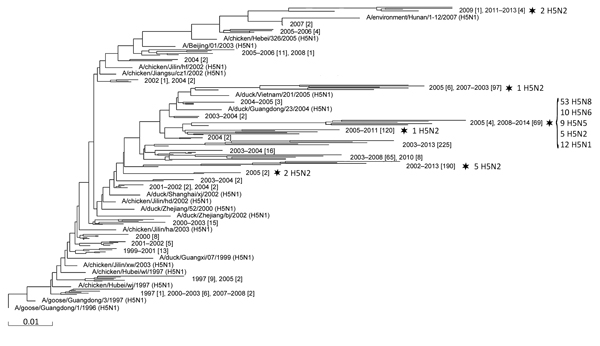Volume 21, Number 5—May 2015
Dispatch
Rapid Emergence of Highly Pathogenic Avian Influenza Subtypes from a Subtype H5N1 Hemagglutinin Variant
Figure 1

Figure 1. Phylogenetic tree showing the evolutionary history of the hemagglutinin (HA) proteins of novel highly pathogenic avian influenza (HPAI) H5 HA subtype viruses. By using MUSCLE (9), we aligned the coding region sequences for 89 HPAI H5 HA subtype viruses, excluding H5N1, with those for 850 H5N1 HA viruses representing all HPAI H5N1 clades (1); the 89 H5 HA sequences were identified in the NCBI Influenza Virus Resource (10) and the GISAID EpiFlu Database (http://www.gisaid.org). A phylogenetic tree was constructed by using the PHYLIP Neighbor Joining algorithm using the F84 distance matrix (http://www.ncbi.nlm.nih.gov/genomes/FLU/DatasetExplorer/fluPage.cgi?pageInclude=References.inc#PHYLIP). The number of sequences present in a branch is indicated between brackets. Stars indicate the branches that contain subtypes other than H5N1. The genotypes (H5N2, H5N5, H5N6, and H5N8) and their numbers of occurrence in a particular branch are indicated at right. Scale bar indicates evolutionary distance (nucleotide substitutions per site). Details for GISAID-derived sequences are shown in the Table.
References
- World Health Organization/World Organisation for Animal Health/Food and Agriculture Organization (WHO/OIE/FAO). Revised and updated nomenclature for highly pathogenic avian influenza A (H5N1) viruses. Influenza Other Respir Viruses. 2014;8:384–8.PubMedGoogle Scholar
- World Health Organization. Cumulative number of confirmed human cases for avian influenza A(H5N1) reported to WHO, 2003–2015 [cited 2015 Jan 19]. http://www.who.int/influenza/human_animal_interface/EN_GIP_20150106CumulativeNumberH5N1cases.pdf?ua=1
- Lei F, Shi W. Prospective of genomics in revealing transmission, reassortment and evolution of wildlife-borne avian influenza A (H5N1) viruses. Curr Genomics. 2011;12:466–74. DOIPubMedGoogle Scholar
- Qi X, Cui L, Yu H, Ge Y, Tang F. Whole-genome sequence of a reassortant H5N6 avian influenza virus isolated from a live poultry market in China, 2013. Genome Announc. 2014;2:e00706–14.
- Ku KB, Park EH, Yum J, Kim JA, Oh SK, Seo SH. Highly pathogenic avian influenza A(H5N8) virus from waterfowl, South Korea, 2014. Emerg Infect Dis. 2014;20:1587–8. DOIPubMedGoogle Scholar
- Lee YJ, Kang HM, Lee EK, Song BM, Jeong J, Kwon YK, Novel reassortant influenza A(H5N8) viruses, South Korea, 2014. Emerg Infect Dis. 2014;20:1087–9. DOIPubMedGoogle Scholar
- Wu H, Peng X, Xu L, Jin C, Cheng L, Lu X, Novel reassortant influenza A(H5N8) viruses in domestic ducks, eastern China. Emerg Infect Dis. 2014;20:1315–8. DOIPubMedGoogle Scholar
- Edgar RC. MUSCLE: multiple sequence alignment with high accuracy and high throughput. Nucleic Acids Res. 2004;32:1792–7. DOIPubMedGoogle Scholar
- Bao Y, Bolotov P, Dernovoy D, Kiryutin B, Zaslavsky L, Tatusova T, The influenza virus resource at the National Center for Biotechnology Information. J Virol. 2008;82:596–601. DOIPubMedGoogle Scholar
- World Health Organization. Evolution of the influenza A(H5) haemagglutinin: WHO/OIE/FAO H5 Working Group reports a new clade designated 2.3.4.4 [cited 2015 Jan 19]. http://www.who.int/influenza/gisrs_laboratory/h5_nomenclature_clade2344/en/
- Liu CG, Liu M, Liu F, Lv R, Liu DF, Qu LD, Emerging multiple reassortant H5N5 avian influenza viruses in ducks, China, 2008. Vet Microbiol. 2013;167:296–306. DOIPubMedGoogle Scholar
- Zhao K, Gu M, Zhong L, Duan Z, Zhang Y, Zhu Y, Characterization of three H5N5 and one H5N8 highly pathogenic avian influenza viruses in China. Vet Microbiol. 2013;163:351–7 and. DOIPubMedGoogle Scholar
- Gu M, Huang J, Chen Y, Chen J, Wang X, Liu X. Genome sequence of a natural reassortant H5N2 avian influenza virus from domestic mallard ducks in eastern China. J Virol. 2012;86:12463–4 . DOIPubMedGoogle Scholar
- Zhao G, Gu X, Lu X, Pan J, Duan Z, Zhao K, Novel reassortant highly pathogenic H5N2 avian influenza viruses in poultry in China. PLoS ONE. 2012;7:e46183 . DOIPubMedGoogle Scholar
1These authors contributed equally to this article.